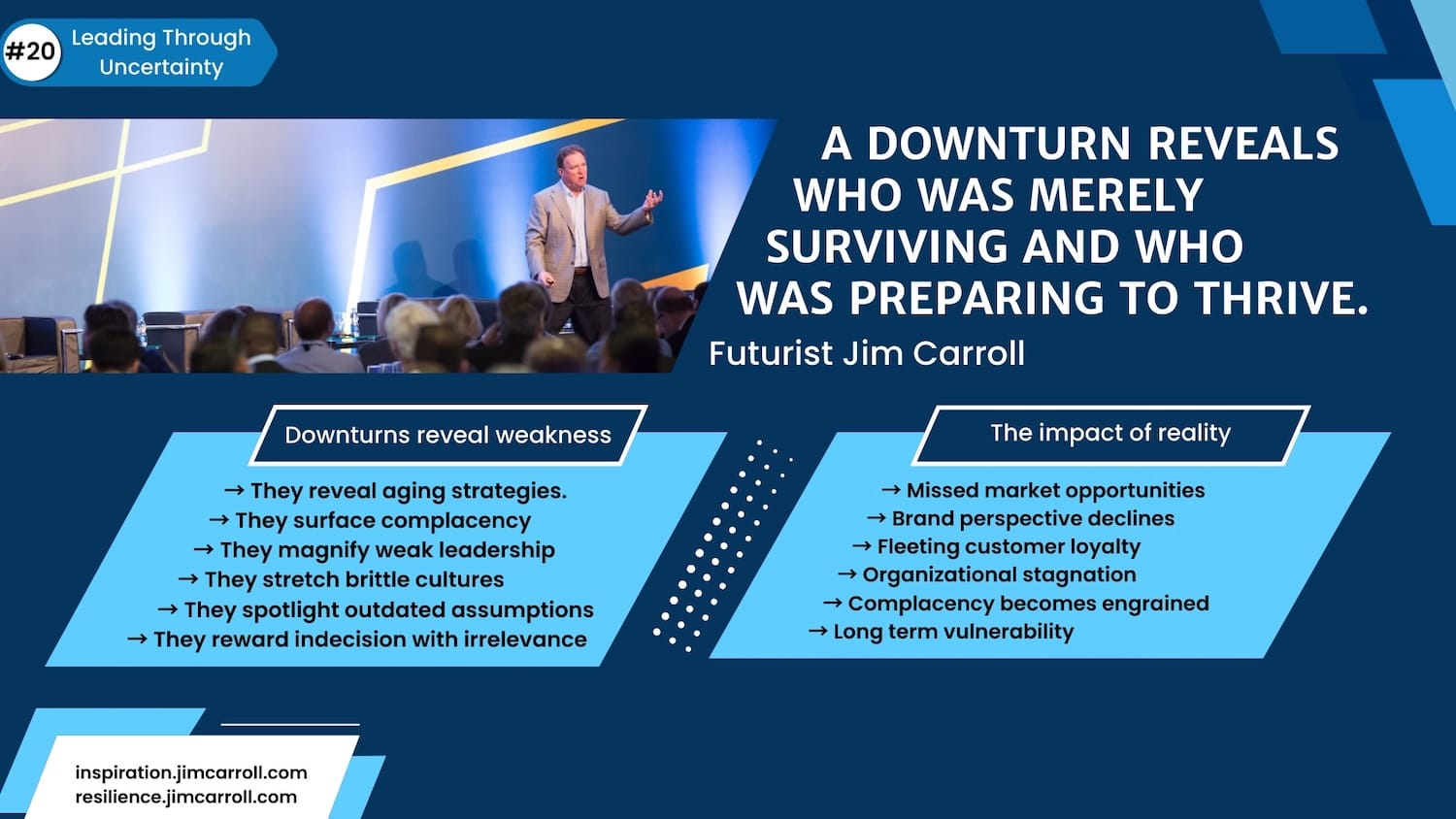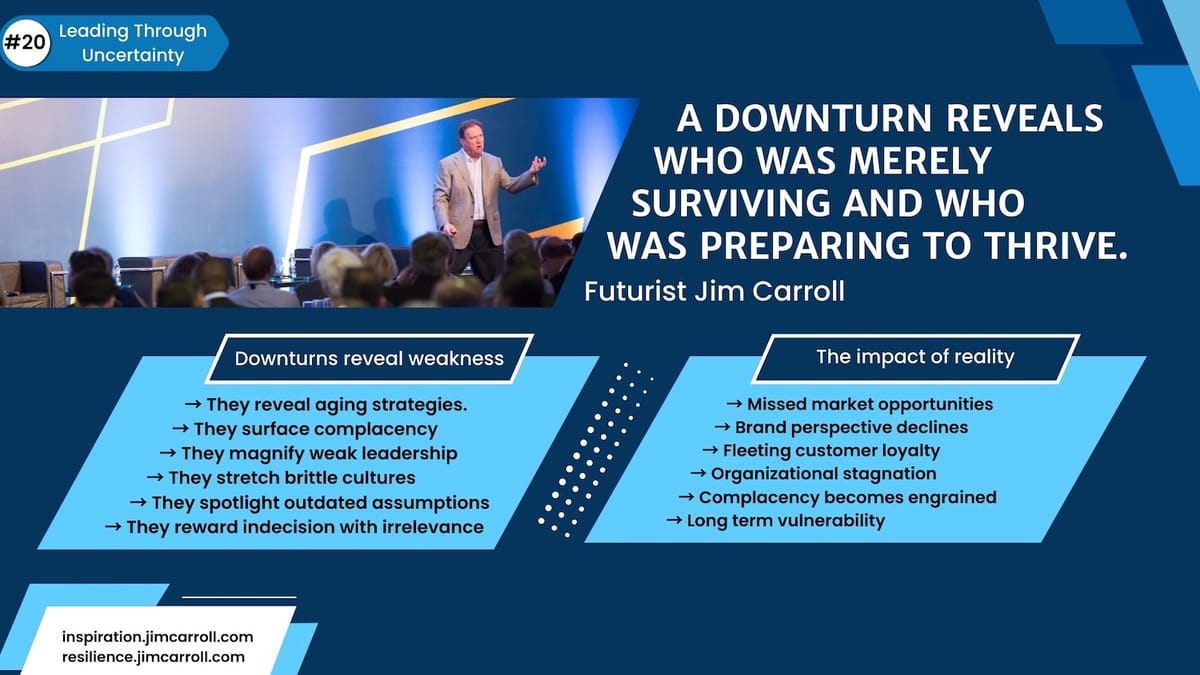"A downturn reveals who was merely surviving and who was preparing to thrive" - Futurist Jim Carroll

What happens when you don’t do the things you should be doing when times are good? Those things you didn't do stick out like a sore thumb when times are bad!
Let’s be blunt: recessions expose the cracks that were already there. And if we’ve spent the last 19 posts building a blueprint for resilience, innovation, momentum, and opportunity — it’s time to talk about the other side of the coin. How recessions make things go wrong, fast, for those who haven't done a great job of aligning to a changing world.
Because not everyone makes it through.
Some organizations stall out. Others collapse entirely. And the reason isn’t usually a lack of potential. It’s paralysis. A lack of organizational agility. A culture that doesn't support fast collaboration. Weakness in the product or service line. Or any other number of systemic, endemic failures that would have been leading the organization towards failure even during the best of times.
In the worst of times, all those weaknesses now becoming glaring, exposed to the harsh light of reality.
Downturns don’t just challenge your organization - they reveal it. They surface complacency. They magnify weak leadership. They stretch brittle cultures. They spotlight outdated assumptions and aging strategies. And most dangerously? They reward indecision with irrelevance!
I've seen this happen in numerous situations. I spent time with Motorola in 2008, just before the great downturn that came later that year. After years of dominance in the mobile phone space, they froze innovation efforts during the financial crisis, cut too deep into R&D, and failed to pivot toward smartphones. Competitors like Apple and Samsung raced ahead. What I saw at the R&D meeting I hosted was an organization that was too focused on regional fiefdoms and budget allocation arguments, and not enough on what needed to be done to align with the reality of the fast technological change surrounding them.
Their downfall was all too predictable because the roots of failure were embedded in their culture before the recession hit. The downturn then helped to take them down. The fact is, it wasn't just a technology failure. It was a leadership failure. Strategy failure. Imagination failure.
Predictable failure.
Organizations that have innovation failure already baked in get caught at blinding speed when a downturn comes. It leads to predictable consequences:
- missed market opportunities because of organizational sclerosis. Companies that delay innovation wait too long to act — and get outpaced by bolder competitors. Nearly 85% of pre-recession growth leaders lose their edge during downturns because they pause while others press forward.
- brand and customer decline because they can't innovate fast enough. Downturns necessitate faster innovation. And yet, organizations that cut marketing, stop customer-facing initiatives or fail to innovate become invisible. Customers drift, loyalty erodes, and relevance evaporates.
- organizational stagnation settles in. Without growth, you lose talent. Energy. Confidence. Internal morale crashes. The most talented people leave. Mediocrity becomes the norm. (Hey, I have a book on that!)
- long-term vulnerability increases because of complacency. Companies that treat recessions as events to “ride out” — instead of catalysts to “reshape” — are left behind when growth returns.
- this complacency becomes the core culture. Over time, failing to innovate doesn’t just impact products or strategy — it rewires your DNA. Risk aversion sets in. New ideas are laughed at. Process overtakes purpose. You become slow. Defensive. Irrelevant.
And in a downturn, those systemic failures send many organizations into a death spiral. Here’s what the research says:
- 30% of the drop in corporate investment in 2008–2009 came from policy uncertainty
- Indecision reduces GDP by as much as 3% during recessions
- Companies that invested strategically during downturns outperformed their peers by 30% in the recovery
In other words: action has a cost — but inaction has a much bigger one!
All this means that you can't just have a mindset to try to survive the downturn - you've got to prepare for the rebound. And you won't be able to do that if you are ill-prepared in the first place. History shows that organizations that don’t build for recovery rarely recover at all because they miss growth windows lose top talent, fall behind on transformation, and begin to shrink while their markets shift.
The damage may not be visible now — but it compounds.
Slowly. Quietly. Fatally.
That's why back in 2009, in one of these posts, I wrote: “The greatest mistake any organization can make right now is to do nothing.”
So what can you do instead?
- Cutting costs? Fine. But don’t cut your future.
- Stressed? That’s a signal to simplify and reinvent.
- Worried? Good — channel it into decisive movement.
Your competitors are waiting, too. You don’t have to outrun the economy — you just have to outrun them. And that means:
- chasing your growth vision
- protecting your innovation budgets, not cutting them
- re-skill your team for future skills in anticipation of an upturn
- streamline, simplify, refocus - rethink everything
- and acting boldly, with speed and intent
A recession isn’t a reason to shrink.
It’s a reason to rethink.
And if you want to be ready for what comes next — you’ve got to move while others pause.
Futurist Jim Carroll is writing a series about leading in uncertainty. Today was going to be the last day in the series, but he has realized he has a few more issues to cover!

